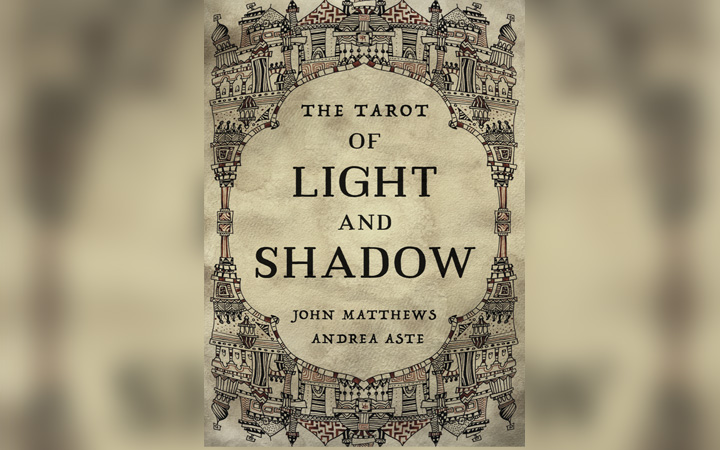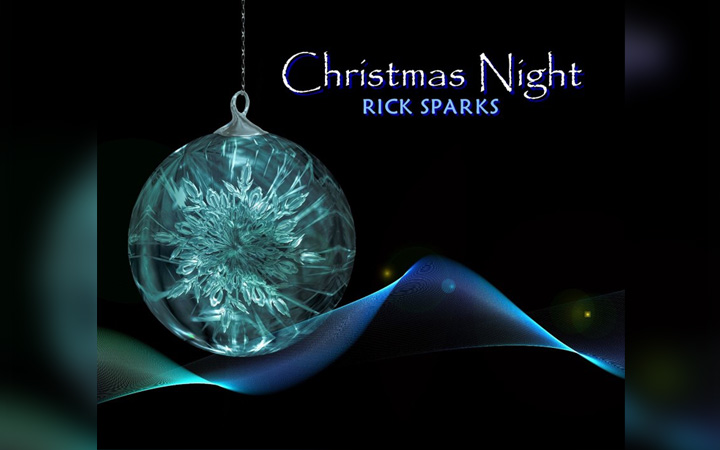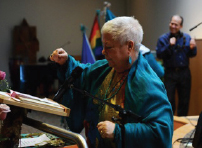The Tarot of Light and Shadow

In this excerpt from The Tarot of Light and Shadow creators John Mathews and Andrea Aste explain how to use their unique and beautiful tarot deck to offer insight into the dualistic nature of life. Readers can explore both sides of a question at once, looking at the Shadow (instinctive, inner world, the unknown) and the Light (rational, outer world, the known). For the first time ever, readers are being offered two tarot decks specifically designed to be used together. This is a directional reading.
Tarot cards tell a story, and it was in this form that the practitioners of cartomancy, the use of playing cards to read possible futures, often couched their interpretations. A fascinating aspect of this was the reading of cards in a directional manner – some cards when placed next to each other will be facing, looking at each other, while others will look away. In the Tarot of Light and Shadow this is a significant detail, since in addition to the natural way in which the cards look toward or away from each other, the pairs of cards in each deck are mirror images, facing toward or away from each other. This adds a wonderful extra dimension to the readings if you choose to work with it.
Significators are the cards chosen to represent either the client or the issue under consideration. Early cartomancers assigned the playing cards to specific types, but we have opted to use any card as a significator, since the pip cards can be interpreted to represent either a person or group which may have influence over the client. The significator can be a powerful card in any reading, and where it lands can be most eloquent, giving insight into the character of the clients, the situation, or other circumstances.
It is from this that the idea of directionality appears to spring. You may notice, if you compare early and modern decks, that the older ones, such as the Tarot de Marseille, tend to look to one side or the other, while from the 20th century onward, they tend to look ahead, meeting your gaze with theirs. As Caitlín Matthews points out in her book on reading early decks, Untold Tarot, “The modern tarot cards behave like mirrors of the viewer’s personality, reflecting some parts of their soul… while the older tarots retain a courtesy and interrelation with each other, with which we can all be included”. Early cartomancers began to consider what the courtiers were looking at – the card that preceded or followed the selected significator. Thus, one might have a card such as the Pope (the Hierophant) next to a King or Queen. If these were looking away from the Pope, they might be turning their backs on a figure of authority. Or, if the card above the chosen significator was a Knight who was looking toward the client card, this might
suggest they are relating to each other in such a way as to influence the situation in the client’s life.
In the Tarot of Light and Shadow this can be expressed in another way, using both decks to discover what influences are being brought to bear on the situation. For example, if you use one of the cosmic mirror or wild cards to choose a significator from the light deck, counting from the top or bottom of the deck how many cards, up or down, to discover where the significator lies, then you can count the same number of cards from the top or bottom of the shadow deck and draw that card. Compare the two – are they facing each other or looking away? What dialogue are they having? In some instances, within The Tarot of Light and Shadow pairs of the same card, such as a pair of Queen of Serpents, will literally mirror each other. Consider how these relate to the client, the issue, or other cards on either side. You can also draw further cards, creating a sequence or “story” from which you can read the answer to the client’s question. Cartomancers seem to have read from right to left but once literacy increased most readers began on the left as they would read a book, and this is the pattern we have followed here.
Most of the cards in the Tarot of Light and Shadow face toward or away from each other. For example, in the Lovers, the women are facing away (but toward their lovers) and the men are facing each other We might ask, who is talking to whom? Or is there a more subtle interplay between light and shadow here? Or, we might consider the Hermit, who in the light deck travels to the left and in the shadow deck to the right. Are they seeking different roads that will eventually lead them to the same place? Who will they meet along the way? Looking at Temperance, the light figure is pouring her vessel into the great cauldron to the left, and looking down, while her twin in the shadow realm, who looks to the right, adds the content of her vessel to a cauldron already bubbling over with life. How does she dialogue with cards on either side?
This is only the beginning of the ways the cards can interrelate with each other. Here are three brief two-card examples, followed by a longer reading.
A WOMAN ASKS ABOUT LEAVING A MANIPULATIVE GROUP
She draws the Queen of Wands (L) and the Devil (S). Here the Queen is turning her back on unwanted attentions or possibly devious activities. Because she is not interested, her tormentors are already losing interest in her. She can walk away.
A MAN HAS TO SPEAK AT HIS STEPSON’S WEDDING BUT CANNOT DECIDE WHAT TO SAY
He draws the Hierophant (S) and the Ace of Cups (L). Both figures incline toward each other. The Hierophant blesses or invokes the power of love, whereas the Ace celebrates a joyful union. The man can make his speech inspirational by focusing on love and faithfulness.
A SINGLE MAN WANTS TO ATTRACT A PARTNER. HOW SHOULD HE GO ABOUT IT?
He draws Strength (S) and the Knight of Serpents (L). Here the Knight faces Strength, who looks away. He should let down his reserves and be prepared to be both charming and charmed. He might start looking in a music venue.
A Longer Reading: Martin is preparing a presentation for an expo in the spring, but a global virus threatens cancellation of the event. What is his best course of action? He draws the following six cards: The Chariot (L), III of Swords (S), Ace of Wands (L) the Tower (L), Judgement (S), Knight of Cups (L). The first five were laid down at once, a sixth one for further information.
Martin is keen and raring to go – the Chariot (L) – but the III of Swords (S) suggests he will be disappointed. The creative force of his ideas, expressed by the Ace of Wands (L), will carry him through even the collapse of the event, represented by the Tower (L). But Judgement (S), facing right, suggests he can still make good with his work. To confirm this, he draws another card which he adds to the line, the Knight of Cups (L), which faces the previous card.
This is just the kind of reciprocal response he is hoping for. The first four cards show the arc of the expo’s closure, while the last two show that he can go online to make his presentation. He does so and receives a warm reception.
––––––––––––––––
Working in this way, either with the two decks separately, or interleaved, a number of fresh meanings are opened up which tell the story offered by the cards in a significant way and allow for greater freedom of interpretation.
About the Author
John Matthews is the New York Times bestselling author of several successful divinatory systems based on early spiritual beliefs – including the Arthurian Tarot (with Caitlin Matthews), the Wildwood Tarot (with Mark Ryan) and the Byzantine Tarot (with Cilla Conway).
Andrea Aste is a multimedia artist, a writer, an animator and a film maker. His theatrical credits include Carnival of Animals at the Teatro Regio of Turin. His most recent deck, The Book of Shadows Tarot, was part of a larger, immersive art project that included a film.






